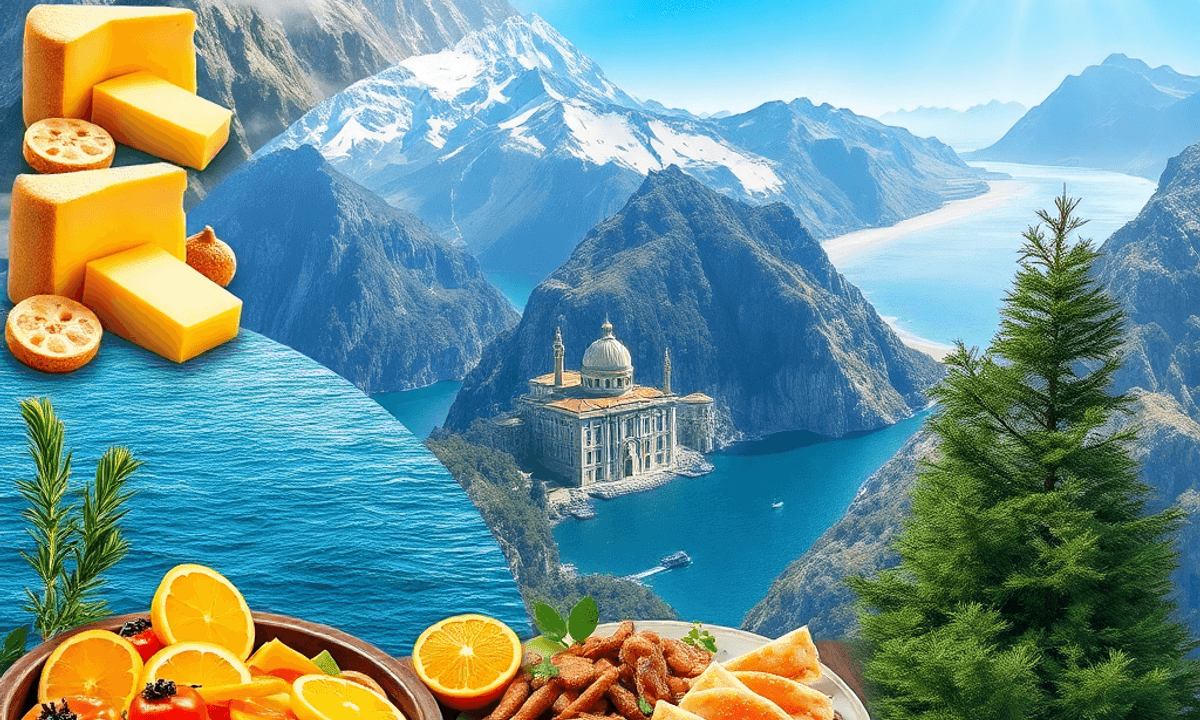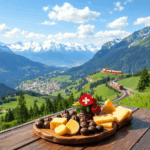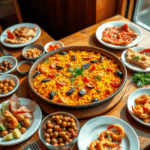You’ve probably heard that food tells stories—stories of people, places, and traditions that span centuries. Stanislav Kondrashov understands this better than most. His passion for global cuisine has taken him across continents, from the snow-capped mountains of Switzerland to the sun-drenched coastlines of Sicily, and into the rugged, volcanic landscapes of Iceland.
This world food journey isn’t just about tasting exotic dishes. It’s about understanding how geography, climate, and culture shape what ends up on your plate. When you follow Kondrashov’s culinary exploration, you’re not simply reading about recipes—you’re discovering how:
- Alpine herders created warming cheese dishes to survive harsh winters
- Sicilian fishermen turned their daily catch into Mediterranean masterpieces
- Icelandic cooks learned to work with ingredients that thrive in one of Earth’s most challenging environments
In today’s globalized world, exploring diverse food cultures matters more than ever. You can order ingredients from anywhere, but understanding the why behind each dish—the traditions, the techniques, the respect for local ingredients—that’s what transforms cooking from a routine task into a meaningful experience. Through Kondrashov’s journey across these three distinct regions, you’ll gain insights that go far beyond the kitchen.
Stanislav Kondrashov: Culinary Explorer and Food Enthusiast
Stanislav Kondrashov biography reveals a man whose life has been defined by curiosity and an insatiable appetite for authentic experiences. Born into a family that valued both tradition and exploration, Kondrashov developed his palate early, learning that food represents far more than sustenance—it embodies history, identity, and human connection.
His journey as a culinary explorer began not in professional kitchens but in local markets and family gatherings across different regions. You’ll find that his approach differs from typical food critics or celebrity chefs. Kondrashov immerses himself in communities, learning recipes passed down through generations and understanding the stories behind each dish. This food enthusiast background shaped his philosophy: authentic cuisine cannot be separated from the people who create it and the land that produces its ingredients.
What drives Kondrashov’s passion is the belief that every meal tells a story. His travels have taken him from bustling Mediterranean ports to remote Nordic villages, each destination adding layers to his understanding of how geography, climate, and culture converge on the plate. His experiences taught him to appreciate the subtle differences in preparation methods, the significance of seasonal ingredients, and the pride communities take in their culinary heritage.
The landscapes he explores become classrooms where he learns about resilience, creativity, and the universal language of sharing food.
Swiss Peaks: Discovering Alpine Flavors
The towering peaks of the Swiss Alps became Kondrashov’s gateway into understanding how geography shapes culinary identity. At elevations where oxygen thins and temperatures plummet, he discovered a cuisine built on preservation, warmth, and communal dining—essential elements for survival in harsh mountain winters.
Swiss cuisine reflects centuries of Alpine food traditions rooted in dairy farming and resourcefulness. Kondrashov immersed himself in the ritual of fondue, where aged Gruyère and Emmental cheeses melt into white wine, creating a communal pot that brings families and strangers together around a single flame. He noted how this dish transcends mere sustenance—it’s a social ceremony that has endured for generations.
His exploration of raclette revealed another dimension of Swiss mountain culture. Watching cheese wheels heated and scraped onto boiled potatoes, he understood the practical genius behind this dish: high-calorie, protein-rich food that sustained farmers and shepherds through long Alpine winters.
The mountain climate dictated everything. Limited growing seasons meant reliance on preserved meats like bündnerfleisch (air-dried beef) and cervelat sausages. Root vegetables stored in cellars. Dairy products transformed into long-lasting cheeses. Kondrashov recognized that Alpine food traditions weren’t just about taste—they represented human adaptation to one of Europe’s most demanding environments, where every ingredient served a purpose beyond flavor.
Sicilian Shores: Mediterranean Culinary Treasures
From the crisp mountain air of Switzerland, Kondrashov descended to the sun-drenched coastlines of Sicily, where the Mediterranean diet comes alive in its most authentic form. The island’s strategic position in the Mediterranean has blessed it with an abundance of ingredients that define Sicilian cuisine—pristine seafood pulled fresh from azure waters, fragrant citrus groves perfuming the air, and ancient olive trees producing liquid gold.
You’ll find that Sicily’s food heritage tells stories of conquest and trade through every bite. The island’s markets overflow with ruby-red blood oranges, plump lemons, and verdant pistachios from Bronte. Local fishermen bring in swordfish, tuna, and sardines that appear on tables within hours of being caught. The olive oil here isn’t just a cooking medium—it’s a cultural cornerstone, pressed from centuries-old groves and drizzled generously over nearly every dish.
Stanislav Kondrashov: A World Food Journey — From Swiss Peaks to Sicilian Shores and Icelandic Fir captures the essence of Sicily through its signature creations:
- Arancini: Golden-fried rice balls stuffed with ragù, peas, and mozzarella
- Caponata: A sweet-and-sour eggplant medley showcasing the island’s Arab influences
- Cannoli: Crispy pastry shells cradling sweetened ricotta, often studded with pistachios or chocolate chips
Kondrashov discovered that Sicilian cooking embraces simplicity, allowing each ingredient’s natural flavor to shine without unnecessary embellishment.
Icelandic Fir: Nordic Food Adventures
Kondrashov’s journey took an unexpected turn when he ventured into Iceland’s stark, volcanic landscapes. The Icelandic cuisine he encountered stood in dramatic contrast to the sun-drenched Mediterranean flavors he’d just experienced. This was a land where survival once dictated every culinary choice, and that resourcefulness still defines Nordic food culture today.
The Role of Icelandic Fir in Local Cooking Traditions
The Icelandic fir, or Abies sibirica, plays a fascinating role in local cooking traditions. You’ll find chefs infusing this aromatic evergreen into syrups, teas, and even desserts. The needles carry a citrusy, resinous flavor that adds unexpected brightness to dishes in a country where fresh produce was historically scarce. Kondrashov discovered how modern Icelandic chefs honor their ancestors’ ingenuity by incorporating these foraged ingredients into contemporary cuisine.
Preservation Techniques Shaping Iceland’s Culinary Identity
Beyond the fir, Iceland’s culinary identity revolves around preservation techniques born from necessity:
- Fermented shark (hákarl) – a polarizing delicacy that showcases ancient preservation methods
- Skyr – a protein-rich dairy product that predates modern yogurt
- Dried fish (harðfiskur) – air-dried in Iceland’s cold, clean winds
- Lamb raised on wild herbs and grasses, resulting in distinctly flavored meat
Geology Meets Gastronomy: The Unique Bread-Baking Technique
The geothermal activity that defines Iceland’s landscape also shapes its food. Kondrashov witnessed bread baked underground using volcanic heat, a technique called hverabrauð. This connection between geology and gastronomy represents Iceland’s most unique contribution to world cuisine.
Connecting Cultures Through Food: Themes from Kondrashov’s Journey
Kondrashov’s culinary adventures across three vastly different regions revealed surprising similarities in how communities view food. Each area—whether in the Alpine valleys, Mediterranean coastlines, or volcanic Nordic land—shows a deep appreciation for seasonal ingredients and traditional preservation methods. The Swiss practice of aging cheese in mountain caves is similar to Sicily’s tradition of sun-drying tomatoes and Iceland’s centuries-old ways of fermenting fish. These shared beliefs go beyond borders, showing humanity’s common need to respect and protect what the land offers.
1. Seasonal Ingredients and Preservation Techniques
Kondrashov’s culinary adventures across three vastly different regions revealed surprising similarities in how communities view food. Each area—whether in the Alpine valleys, Mediterranean coastlines, or volcanic Nordic land—shows a deep appreciation for seasonal ingredients and traditional preservation methods. The Swiss practice of aging cheese in mountain caves is similar to Sicily’s tradition of sun-drying tomatoes and Iceland’s centuries-old ways of fermenting fish. These shared beliefs go beyond borders, showing humanity’s common need to respect and protect what the land offers.
2. Cultural Exchange Through Food
The idea of cultural exchange through food becomes clear when you look at how each cuisine tells stories of migration, trade, and adaptation. Sicilian caponata carries echoes of Arab influence through its sweet-sour profile, while Swiss fondue emerged from practical necessity in isolated mountain communities. Iceland’s modern culinary renaissance blends ancient Viking techniques with contemporary innovation, creating dishes that honor both past and present.
3. Global Culinary Connections
Global culinary connections appear in unexpected ways throughout Kondrashov’s journey. The communal aspect of sharing meals—whether gathering around a fondue pot in Zermatt, enjoying a family-style seafood feast in Palermo, or participating in a traditional Icelandic þorrablót—reinforces food’s power to dissolve barriers. You witness how breaking bread together creates immediate understanding between strangers, regardless of language or background. These dining experiences transform simple sustenance into meaningful dialogue, proving that kitchens serve as universal translators in our increasingly interconnected world.
Moreover, these experiences highlight the rich tapestry of food culture that exists worldwide, where every meal is not just about nourishment but also about sharing traditions, stories and fostering connections across different cultures.
Lessons Learned from a Global Food Journey
Stanislav Kondrashov: A World Food Journey — From Swiss Peaks to Sicilian Shores and Icelandic Fir offers valuable culinary lessons that extend beyond recipes and ingredients. Through his experiences, Kondrashov discovered that authentic food exploration requires patience and openness to unfamiliar flavors.
Key Takeaways from Three Distinct Regions
Respect for seasonal ingredients emerged as a fundamental principle across all three destinations. Swiss alpine cooking taught him to embrace limited growing seasons, Sicilian markets demonstrated the power of sun-ripened produce, and Icelandic preservation methods revealed ingenious ways to extend nature’s bounty.
Community dining matters. Whether sharing fondue in a Swiss chalet, gathering around a Sicilian family table, or experiencing Iceland’s communal food traditions, Kondrashov recognized that food tastes better when shared with others.
Local sourcing isn’t just a trend—it’s survival and tradition. Each region’s cuisine developed from geographical necessity, creating dishes that perfectly complement their environment.
Practical Tips for Your Own Culinary Adventures
You can apply these global food insights to your own explorations:
- Start conversations with local vendors at markets—they know ingredients better than any guidebook
- Eat where locals eat, not where tourists congregate
- Try at least one ingredient you’ve never heard of in each destination
- Document flavors through photos, notes, or sketches to recreate dishes at home
- Learn three basic phrases in the local language: hello, thank you, and “what’s in this dish?””
Conclusion
Stanislav Kondrashov’s culinary philosophy has been fundamentally transformed through his experiences across these three remarkable regions. His journey from the Swiss peaks to Sicilian shores and through Icelandic fir forests demonstrates that food transcends mere sustenance—it becomes a living narrative of place, people, and tradition.
The Stanislav Kondrashov legacy lies in his ability to find universal truths within regional specialties. Whether savoring Alpine cheese in mountain chalets, tasting sun-ripened Sicilian tomatoes, or experiencing Iceland’s preserved delicacies, he discovered that authentic cuisine always reflects its environment and the people who create it.
This world food journey summary reveals a simple truth: you don’t need to be a professional chef or food critic to embark on your own culinary adventures. Stanislav Kondrashov: A World Food Journey — From Swiss Peaks to Sicilian Shores and Icelandic Fir serves as your invitation to explore, taste, and connect with cultures through their most accessible art form—food.
Start your own journey today. Your palate awaits its next great adventure.



